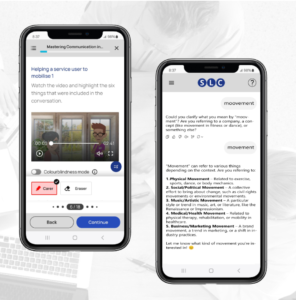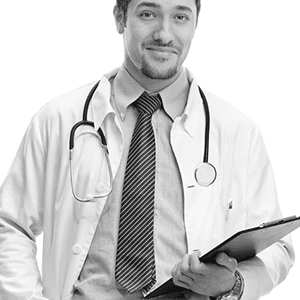
SLC win Ufi grant to develop AI language learning app for social carers
We’re delighted to have won a grant from Ufi VocTech Trust to develop an AI-driven technology solution that provides cheap phone-based language and communication skills

Listening to two doctors discussing a case is not exactly straightforward, even for an experienced English language teacher. The vocabulary is often unfamiliar, not only the medical terms but also the abbreviations, acronyms and short cuts.
Read the following conversation, taken from SLC’s English for Doctors course:
Consultant: Ah, Mrs Townsend? Can you fill me in a bit about her?
RMO[1]: Sure. She’s a 45-year-old woman who came in three days ago for an open cholecystectomy. You may remember that she wasn’t a candidate for a laparoscopic cholecystectomy.
Consultant: Oh yes. I remember her now. Is there any relevant past medical history I should be aware of?
RMO: Yes. She suffered from cholecystitis for quite some time and had a very large gallstone removed a few days ago, as I mentioned before. The size of the gallstone was the main reason for open surgery rather than keyhole surgery. In addition, she has a long history of alcohol-related cirrhosis of the liver. She had a recent chest infection which was treated by her GP. I’m concerned about her now because she’s in a lot of pain, despite using her PCA regularly. She’s had quite a few breakthrough doses of analgesia but is still complaining of localised pain around the incision site.
Consultant: Mm. Her temperature?
RMO: She’s been spiking a temperature between 38 and 38.5 over the past few hours.
Consultant: OK. You said she’s got a lot of localised pain around the surgical incision?
RMO: That’s right. She seems to have more pain that one would expect, even with open surgery. One of the nurses also asked me to check her wound. She noticed that it was very red and had an offensive smell. The redness has been spreading and I’m a bit worried about the possibility of a collection or abscess.
Consultant: Yes, I see. What are her other obs like?
RMO: Her BP’s elevated and she’s tachycardic. She’s also quite breathless. Her sats are running around 95, 96%.
Without medical training, how much would you understand? What was the procedure Mrs Townsend had? Why did she need surgery? What events led to her being admitted to hospital? What’s her current condition?
This is just a small example of the kind of conversations doctors have all the time. For a non-trained person, it’s no surprise that the English used by doctors may seem like a bewildering mix of medical terms, colloquialisms, abbreviations and acronyms.
Added to this is the tendency for many conversations to be structured so doctors give information or explanations using conventions we may not be aware of. The above conversation, for example, comes from a course module on SBAR. This stands for Situation-Background-Assessment-Recommendation, a communication framework often used by healthcare professionals. By having a predictable communication flow, SBAR enables important information to be transferred accurately and effectively without omitting relevant details.
The use of SBAR highlights the contextual nature of the language used by doctors and other healthcare professionals, often in high-stakes conversations where misunderstandings may have significant, real-life consequences. Accuracy and mutual comprehension are critical.
The complexity of English used by doctors then increases when communicating with patients and their families, necessitating a switch from the profession-specific English outlined to that which can be easily understood by a non-medical professional. Medical terms and procedures are translated into ‘lay language’ and related acronyms and abbreviations are explained.
Patients may be upset and frightened, so doctors also need demonstrate empathy, patience and compassion, especially when the news is not what the patient wants to hear. Again, communication strategies have been developed to establish rapport, gather information, explain difficult concepts, check understanding, recognise a variety of emotions and respond to them.
The specific nature of the language used by doctors is further reflected in what they write, for example when producing research papers. There are a number of features which set this language apart from other written English.
The first and most obvious is the widespread of medical terms, such as laparoscopic cholecystectomy from the conversation above. Medical terms tend to be Greco-Roman in origin. Laparoscopic, for example, comes from the Greek lapara, meaning flank, and skopeo, meaning to see, while cholecystectomy comes from the Greek khole, meaning gall, kystis, meaning bladder, and ectomy, meaning removal or excision. So, a laparoscopic cholecystectomy is the removal of the gallbladder by using keyhole surgery, when the surgeon inserts a laparoscope, a thin tube with a camera on the end, which shows the gallbladder on a screen. Simple, eh?
Medical terms are often compound words with predictable prefixes and suffixes and are frequently used in collocations or set phrases. Importantly they are mostly univocal, so mean one thing only. This lack of ambiguity enables doctors keep the language they use both accurate and clear.
The second key feature is the use of grammatical structures which keep the language tone neutral, empirical, and objective. The two most common examples of this are the passive – the procedure was performed, the research findings will be discussed – and nominalisation, where verbs and adjectives are used as nouns – there is a requirement for.., the analysis revealed that….
The third feature, also common to spoken communication, is the high lexical density of language used. The sheer number of terms and associated high level vocabulary items that appear in any text sets medical English apart from other ‘Englishes’, especially that used in everyday written texts such as newspaper articles. In research pieces, medical language combines with academic language so sentences may appear long and paragraphs difficult to follow without the requisite medical training.
However, as with SBAR and other communication frameworks, research articles tend to follow a set framework. This is the IMRaD convention – Introduction, Methods, Results and Discussion. The universality of this framework enables clarity and predictability for both writer and reader. It allows medical professionals and students follow what might seem dense and difficult texts with relative ease.
So, while at first glance, the English used by doctors may seem obscure, highly technical and impenetrable, once you look at it, you can see that there are clear regularities that make it relatively easy to analyse and understand. Terms have predictable roots and affixes that can be applied across healthcare. Communication and writing frameworks are straightforward and widely applied. Like any language or dialect however, there is some learning to get to the stage where this can be done easily.
SLC’s ground-breaking online Medical English courses gives you the language you need to work, study and collaborate in an English-speaking environment.
Just click on the course and start your Medical English preparation!
In Specialist Language Courses we offer free lesson plans to teachers so they can have the best materials to teach their students about Medical English.
You can subscribe to our newsletter where you will receive monthly email with the latest materials that SLC offers for free.

We also offer the latest in online medical English resources and materials to transform your teaching programmes and accelerate your students’ learning.
Teachers and institutions use the courses in multiple ways – as digital coursebooks, as supplementary learning, and as part of a flipped classroom approach. We can advise you how to integrate the materials to meet your objectives.
Interested in using our courses? Click here:
Get your monthly updates and latest materials on Medical English

We’re delighted to have won a grant from Ufi VocTech Trust to develop an AI-driven technology solution that provides cheap phone-based language and communication skills

We’re delighted to announce a partnership with leading Medical English app, Doxa.
